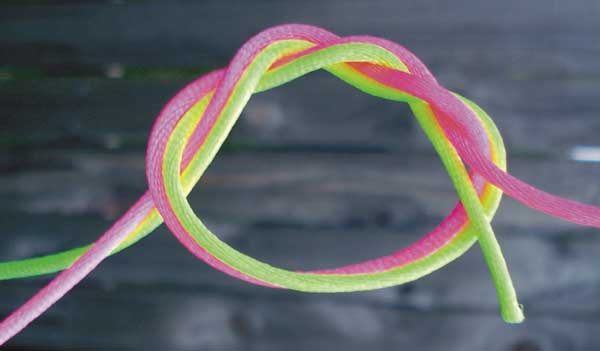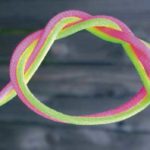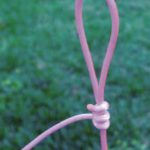
There’s an epidemic going around: folks hooking into nice redfish only to lose the fish, and their flies, during the struggle.Losing flies often indicates a problem with leaders and knots. It may not be fashionable to get rid of leaders, but you need to dump what you have and make some fresh new ones.
And to help you get there, we suggest getting a book on knots, some rattail cord and a paper clip.
For those readers new to fly fishing, the leader is the monofilament connection between the fly and the fly line. As with lure fishing, you want the fish to think there are no strings attached to the offer you’re making. So the “tippet,” that section of the leader attached to the fly, should be as thin as possible but not so weak that a typical fish you encounter can break it.
The other end of the leader — that section tied to the fly line — is called the “butt” section. You want a big butt — no, not personally, but for your leader. Most leaders are tapered from thick to thin across their length.
A tapered leader improves the odds that when the forward cast stops, and the fly line ceases its forward motion, the energy imparted by the fly line will transfer efficiently from fly line to leader to fly. The result will be that the fly settles at the maximum distance from the fly line.
If you’re casting to a cruising redfish or a bass sitting on a bed, you want the fish to see the fly and not the fly line.
A good leader begins with good material. The “leader material” or “tippet material” found in fly shops is manufactured to precise tolerances to ensure maximum strength per diameter.
Choose the right material for the job. Flourocarbon sinks, so it’s not a good choice for fishing dry flies, poppers or even sinking flies under a VOSI (fly rodder’s popping cork). Conversely, if you’re fishing a weighted fly or streamer in clear water, flourocarbon greatly improves your success.
A good leader also needs good knots. There are countless websites and books featuring dozens of knots and how to tie them. Keep it simple by learning just a few good, simple knots.
With a leader, you have three types of connections: terminal (tippet to fly), segment (mono to mono) and alpha (fly line-to-leader).
My recommendations for the alpha connection are the nail knot and the uni-knot. My favorite knots for segment connections are the surgeons, and double-uni. For terminal connections, I use the improved clinch, Turle, Duncan’s loop, and the non-slip mono knot.
The “uni” stands for “universal,” as this knot, in various forms, is used for all three types of connections. The Duncan’s loop is a variation of the uni-knot. Another universal knot you should learn is the surgeons. Variations of it include the triple surgeons and the surgeons loop.
Definitely learn the surgeons and the uni family of knots. These are easy to learn, fast to tie, and unless you’re strictly an offshore angler, can cover nearly all your fishing situations.
Fluorocarbon doesn’t compress, so most knots using this material will slip. The Uni-knot in all its variations holds up. A triple surgeons knot will work also. If you think of a surgeons as a double granny knot of two lines, then a triple surgeons is simply an extra “granny” added in.
A common mistake anglers make when tying knots with fluoro is that they immediately trim the tag ends close to the knot. Instead, leave a little bit on the tag ends just in case the knot slips some under the stress of a heavy fish.
If you browse the internet, you’ll find a wide range of opinions on every knot. I recall early in my flyfishing life reading how difficult it was to tie a blood knot, and because it was only 80 percent line strength, it was not recommended.
Then on a trip one summer to Montana, I discovered why midge fishermen use blood knots. I made my segment connections using surgeons knots, which are twice as bulky as the bloods. The trout would rise and strike the knots. Switching to blood knots alleviated that problem.
The blood knot is one of many that can be difficult to tie, but it doesn’t have to be. When I do introductory fly fishing classes, I usually have different-colored sections of rattail cord for students to learn knots with. The brightly-colored and flexible cord allows students to get familiar with each knot visually, while training their subconcious mind to do the knot. A paper clip is used in lieu of a hook. I found this combination saves a lot of frustration over trying to learn using mono — not to mention far fewer finger pricks from a hook.
Perhaps the most difficult of the common knots used is the nail knot. In recent years, most fly line manufacturers have gone to adding loops at the end of their lines. This avoids the need for the nail knot. Instead, you can tie a surgeons loop or perfection loop at the end of your butt section, and then pass it through the eye of the fly line loop to make an interchangeable connection.
Loop-to-loop connections also serve well for making quick changes to one’s leader.
For example, let’s say I’m casting poppers to redfish, and then decide to chase after them in deep cuts using small Clousers.
For the wind-resistant poppers, I might have used 18 inches of 16-pound tippet. In deep water, I need thin tippet to get my fly down fast, and turnover is not an issue since the Clouser is weighted and has no wind-resistance. So my new tippet might be 30 inches of 12-pound mono.
FFF Gulf Coast Expo
The Gulf Coast Council, Federation of Fly Fishers (FFF), will hold their second-annual flyfishing show on May 16-17 at the Lake Charles Civic Center in Lake Charles.
The show runs from 8:30 a.m. to 4:30 p.m. both days, and is open to the general public. Admission to the show is just $10 for an individual and members of their immediate family.
The show features programs, fly tying, exhibits, tackle manufacturers, kayak makers, outfitters, outdoor artists, rod builders and much more. Attendees can also get free instruction in fly casting, fly tying or basic knots. Dozens of the top fly tiers from Texas to Florida and other parts of the country will be on hand to exhibit their patterns.
In addition, limited-entry workshops are available, each for a reasonable fee, where students can get personalized instruction in some special aspect of fly fishing or fly tying. Equipment and materials are provided.
For more info, or to register, check out the GCC-FFF website at www.gulfcoastfff.org.




